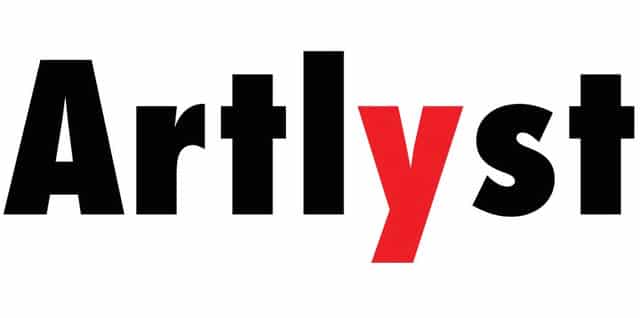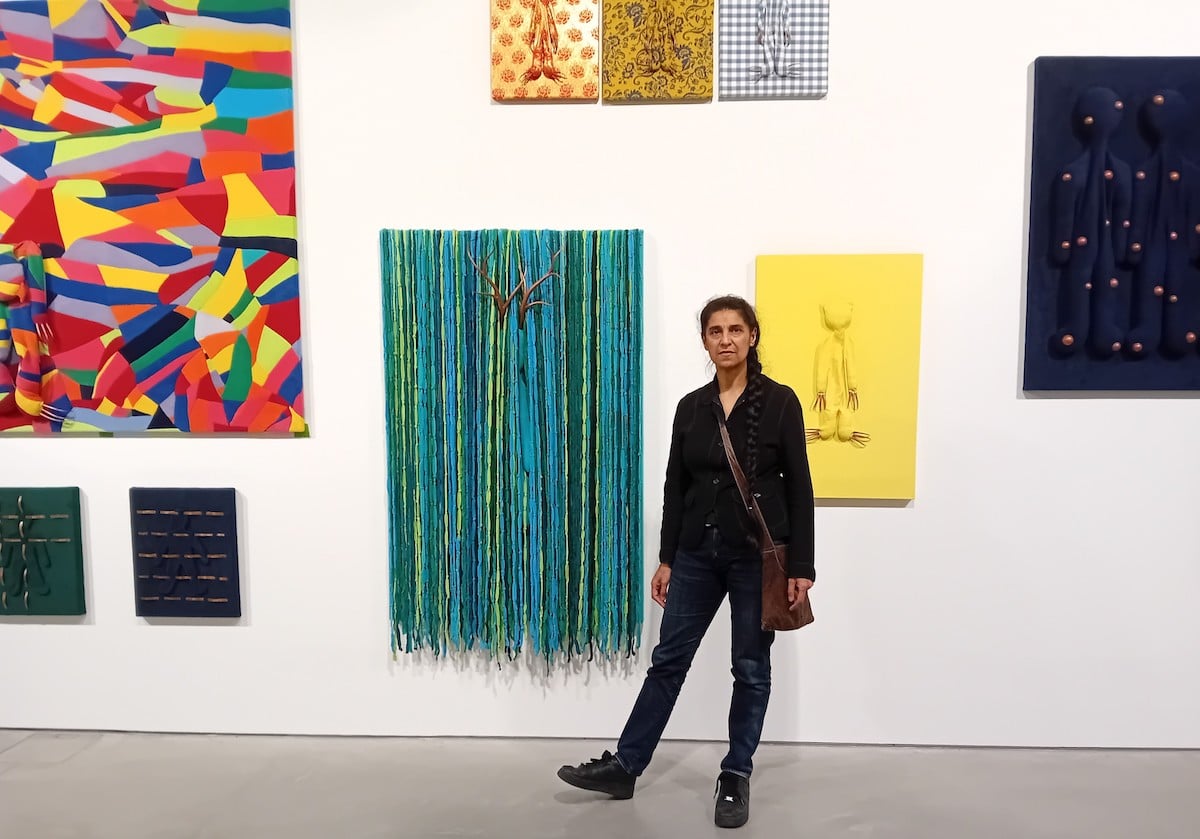Permindar Kaur’s thirty-year career survey at the John Hansard Gallery, Southampton, is titled ‘Nothing is Fixed’. As that suggests, her work maintains ambiguity between possible interpretations, leaving the viewer to decide. Kaur divides the show into five distinct spaces in which that plays to which the show is divided: what you might call ‘the wall of hiding’, ‘the room of rooms’, ‘the bedroom’, ‘the hunting zone’ and ‘black teddy world’.
There are echoes of childhood, for example, in your use of what might be soft toys. What led to that?
I never use real objects, I always make them, which makes the work one step removed from the real world and often enter the fantasy world of fairy tales. The work looks like it’s about childhood, but it’s never been about my own, but more as a way to explore the uncanny . A lot of my work is rather like a child’s drawing: there’s a naivety and simplicity to my visual language, because I want the work to be visually direct – but not so direct in meaning.

Permindar Kaur Installation view with the Camouflage series, 2012-24
The show opens with a dense hang of 35 fabric and copper works in which animals and figures are camouflaged to varying degrees. What is the idea?
I wanted to suggest a manor house or country estate, using a salon or academy hang to imply this, a ‘room’ that indicates power and control. This is set against the new Hunting Chair (2024), which can be seen as a class-focused object. There are sloths and birds and figures that might be human or animal – or they could also be dressing-up costumes. Camouflage is interesting as you are either hiding or waiting to attack – they might look passive, but their claws are sharp and they could be used. Defence and protection runs throughout my work. Camouflage also implies adaptation, trying to fit in. I want to see which fabric offers the best camouflage… the more patterned the fabric, the easier it is for the figure to hide. With the single-colour ones, I wanted to see how the copper claws responded to the different colours. In the early canvases, the figures have claws, whilst in the later ones the copper becomes more part of the pattern. Some are set against an expanse, so they look lonely. Others are squashed into a canvas that is too small for them – if they stood up, there wouldn’t be room for their antlers. In some, I experiment with the figure not being visible, but you know it is there. The salon hang gives everyone a choice about what they are drawn to, and allows them to see all those strategies at play.

Permindar Kaur ‘Flowers & Bumps’, 2013-23 – Fabric and copper
‘Flowers & Bumps’ is rather different?
Yes, that’s why I hung it centrally. The copper in these figures isn’t claws: three have bumps sticking out, and one has flowers on it. They are not fully camouflaged – as I haven’t put bumps in the background – so it’s more about the relationship between the figures. I like it because it is mysterious, it’s more ambiguous. Do the bumps eventually become the flowers? The convex bumps do fit into the flowers, as I’m using the same forms. Or the bumps could be illness, or stars, making it a night scene. And are they on the body or the clothing?

Permindar Kaur ‘Room 6 – Circle, 2024 – Steel (Photo Richard Davies)
There’s also lots of furniture sculpture. The second space shows various rooms within the room, each with an arrangement of chairs…
Furniture is a regular feature of my work, they are everywhere around us, as an extension of ourselves. I like the recognisability of beds and chairs. My furniture is active, so the ‘Circle’ of chairs seem like they’re marching, reminding me of Disney’s ’Fantasia’. But they’re caught in a circle, going nowhere. I’d like to make this huge, towering above us, but that would be technically difficult – as the furniture are walking, they have no centre of gravity, so it would be hard to keep them stable at scale. As they haven’t actually left the room or plinth, it isn’t clear if they will change. In another – ‘Room 5 – Chairs’ – I’m also touching on ideas around individuality and collectivism.

Permindar Kaur ‘Untitled (Bed)’, 2020 – Steel, fabric, copper and stuffing (Photo Richard Davies)
The central feature of the bedroom space is ‘Untitled (Bed)’, with many coloured creatures beneath a black bedframe. That’s from 2020?
This work was first shown during the pandemic in an exhibition called HOME for HS Projects. Some thought the ‘bugs’ under the bed were microbes that I had enlarged, so you could see them. But the work was conceived before Covid, and the more obvious reference was of monsters under the bed and a fear of the unknown. You might associate that with a child, but it’s not a child-sized bed. Counterintuitively, I see it as making peace with your monsters. There’s no mattress, so it seems no one is sleeping there any more. You could make up stories… Perhaps the owner’s gone, he doesn’t realise that these creatures have taken over the house. But why shouldn’t they live there? I reduce them down – no arms or legs and – as in all of my figures – no facial features. I want the creatures to be ambiguous, not to be read directly as microbes or beetles. And the claws on them could also read as fur – you could stroke them. And it’s like sea of claws. I want people to be unsure how to react to these creatures living under the bed.

Permindar Kaur ‘Hunting Chair’, 2024 – Steel and fabric
The newest work in the show is in the room overlooking the square outside, with a four metre high ‘Hunting Chair’ in the seven metre-high space. What sort of hunting would that be used for – the pedestrians down below?
I like making things tall. Not many people know what a hunting chair is and they’ve tried to google ‘hunting chair’ and can’t find a picture of one! Hunting chairs normally have arm rests and a cross bar at the top, and have a wider seat, giving a more secure place to sit. They are usually attached to a tree, so they don’t have the back poles. This sort of chair would be used in Sweden to hunt wild boars. But I didn’t want to just copy a hunting chair, I wanted it to have domestic connotations. People might also be reminded of a giant toddler chair, or a lifeguard chair, but I thought if I called it a hunting chair, that would be enough. If you go that high, it’s a position of privilege, but it’s also quite precarious to sit up there. And not too comfortable, even though I’ve added the domestic touch of a cushion – whereas hunting chairs are there all the time, they’re just made out of wood. Around the chair I’ve placed flowers on the floor, implying a carpet, but not in a pattern, more like a scatter of flowers. High up are what look like hunting trophies on the wall, but these are based on plant forms.

Permindar Kaur ‘Ten Teddies & Barrier’, 2017 – Steel and fabric
The last two rooms are dark, and their inhabitants are black teddies. The main installation is ‘Ten Teddies & Barrier’. What’s going on there?
In contrast to the colourful forms of the camouflage works, for two years I made teddy bears in a black woollen fabric. They developed out of the camouflage figures, but I wanted them to be more substantial, and stand on their own – the focus to be on their colour and pointed ears, whilst still resembling children’s teddies. The barrier is really important to this work, I wouldn’t show them without it – it’s this relationship between the materials, again, but also a contrast in shape, soft edges against sharp points. Is it like entering a child’s playground, with a barrier protecting / containing the children? The barrier is precarious, as it’s balanced on points. And it’s a bit like a walking barrier that can shift its position, adding to the unease. Viewers can walk around it. Had the fence trapped the teddies by going all the way across, that would have been less ambiguous.
What are the teddies doing?
I’m not sure – I want people to wonder whether these teddy bears are friends or foes, are they cuddly or dangerous or both? People have called them ‘devils in making’, with their pointed ears. Two of them can be read as a mother looking out for a child, but is he sleeping or ill? A group of three are enclosed, facing each other. Are they plotting, and if so what are they planning to do? Another pair could be in conversation or confrontation. I do tend to focus on the home, but this feels more like a playground, courtyard or prison.
Top Photo: Permindar Kaur in her salon hang courtesy Of the Artist
Permindar Kaur: ‘Nothing is Fixed’ is at the Hansard Gallery, Southampton to 7 September


